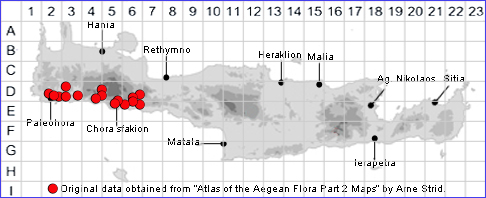SPECIES DESCRIPTION
TEUCRIUM CUNEIFOLIUM
Family and Genus:- See- LABIATAE/Sect. POLIUM
Common Names:- None
Homotypic Synonyms:- None
Meaning:- Teucrium (Gr) A name used by the Greek physician and botanist
Dioscorides, perhaps for the hero and first King of Troy, Teucer.
Cuneifolium (L) With wedge-shaped leaves.
General description:- Much-branched dwarf shrub.
Stems:-
1) 10-25 cm, ascending, densely green- to white-tomentose.
Leaves:-
1) 9-13 mm, at least 8 mm wide, ovate to orbicular, with 3-4 crenations, cuneate at
the base, shortly petiolate, densely green- to white-tomentose.
Flowers:-
1) In terminal or axillary heads.
2) Bracts;
a) lower, leaf-like.
b) upper, entire, spathulate.
3) Calyx, 5-7 mm, hairy; veins obscure.
4) Corolla, cream, proximal lobes spathulate.
Fruit:-
1) Nutlets, smooth or reticulate.
Key features:-
1) Corolla, c. 10 mm, pale yellow, with spathulate lateral lobes.
2) Leaves, c. 10 mm wide, densely white- or yellowish-tomentose, suborbicular with
3-4 conspicuous crenations on either side
Habitat:- Crevices and ledges of limestone cliffs, occasionally in scree at the
bottoms of gorges. 0-300(-650) m.
Distribution:- Endemic SW. Crete. mainly in gorges in the foothills of the Lefka
Ori.
Flowering time:- May-June, occasionally later.
Photos by:- Fotis Samaritakis
Status:-
Conservation status (for threatened species): Rare (R) according to IUCN 1997
Protection status (for threatened species): Greek Presidential Decree 67/1981

